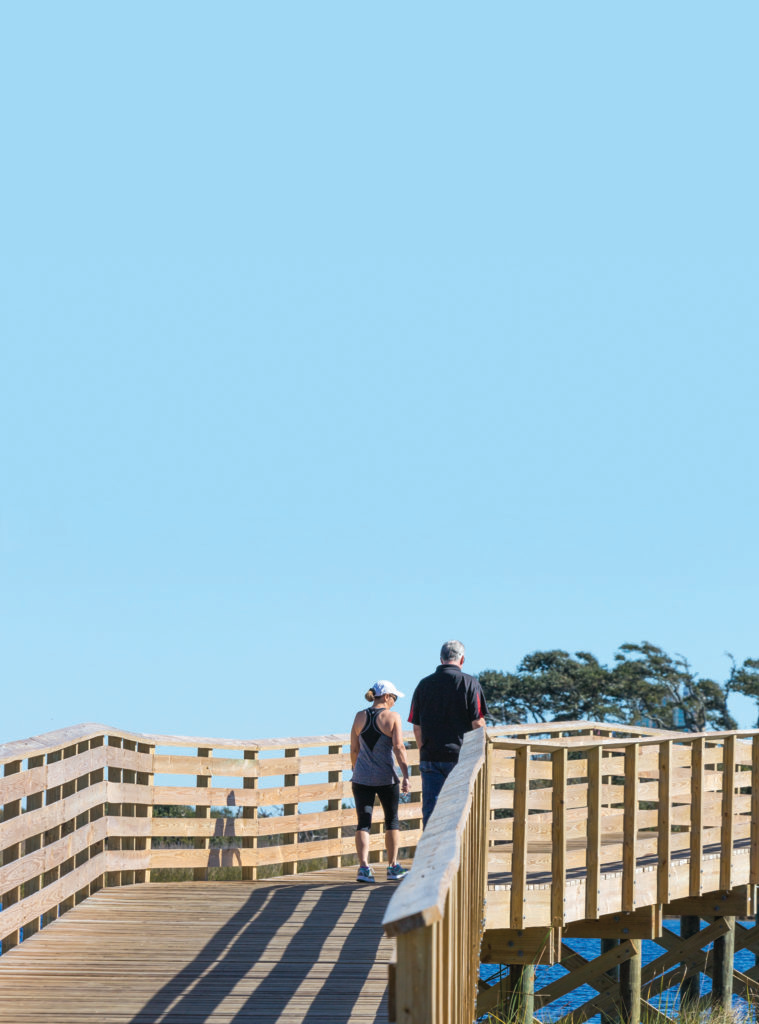
State parks offer trails for beginners to experienced hikers and cyclers
By Lenore Vickrey
If you’re looking for a trail to walk, hike or cycle, Alabama’s state parks offer the largest variety to choose from, with 21 state parks and 48,000 acres of land, which includes 250 miles of trails.
Usage of the parks jumped 32 percent in 2020, with 1.5 million more visitors than the year before, mainly due to the pandemic. “We made the active decision to keep our parks open for our guests and the state of Alabama,” says Jerry Weisenfeld, director of advertising and marketing for the state parks system. “We were pleasantly surprised that the parks were viewed as safe, reliable healthy alternative to staying indoors. It shows that people wanted to get outside.”
At Cheaha State Park in northeast Alabama, superintendent Renee Rainey estimates there was at least a 60 percent increase in use of its 17 different trails in 2020. “Our highest increase was in day visitors, but we also saw increases in camping,” she says. “People realized it was safer to be outside, where they were in charge and bringing their own supplies.”
“People felt safe in the outdoors and really hit the rails and campgrounds all over north Alabama,” agrees Tami Reist, president and CEO of the Alabama Mountain Lakes Association. “Our areas where there are more opportunities for outdoor recreation like hiking and camping have definitely seen an uptick in visitors since (the pandemic).”

Lamar Pendergrass, operations supervisor for the parks’ South region, reports similar increased activity in that area, which includes all state parks south of Montgomery from Chewacla near Auburn, known for its diverse mountain bike trail system, to Gulf State Park on the coastline.
Trail walkers, hikers and cyclers have 28 miles of paved trails or boardwalks to choose from at Gulf State Park, including seven trails of the Hugh S. Branyon Backcountry Trail complex, featuring nine distinct ecosystems.
“When the pandemic hit, the parks were one of the few outlets that were open to people, to get out in nature,” Pendergrass says. “Our trail system interconnects, and you can turn a one and a half-mile walk into a three-mile walk if you want. Not only are these trails accessible to walking, but also to bicycles.”
Raney reports she saw a lot of “newbies,” first-time visitors to Cheaha State Park who’d never thought about visiting a state park before. “But with COVID and feeling safer outside, now they’re hooked!” she says. For many, it was the first time they’d ever hiked or camped. The park saw a lot of visitors from Atlanta, Birmingham and other urban areas, from families to couples to solo hikers.
“The main thing,” Raney says, “is for anyone who hadn’t visited a state park, there is something for everyone, and it’s not a difficult journey from anywhere in the state. It will be a memory-making experience and so good for you! Whether you’re walking or hiking, it decreases depression, reduces your blood pressure and boosts your immune system.”
As the highest point in Alabama at 2,407 feet above sea level, Cheaha is famous for its scenic views, especially on Bald Rock Nature Trail. The trail itself is only .3 miles long, “but winds its way to one of the most beautiful outlooks in the park,” says Raney. “You can see all the way to Flagg Mountain, the sister mountain to Cheaha.”
The park is called an “island in the sky,” she adds, “because we are consistently surrounded by clouds and the sunsets are incredible.”
For more information:
- On Alabama’s state parks, alapark.com and go to the specific park you’re interested in.
- On trails in Alabama’s state parks, alapark.com/trails/trails-alabama-state-parks. Each park also has its own Facebook page.
- On Trails in north Alabama, northalabama.org/trails/
- Trails for walking and hiking are also plentiful in Alabama’s four national forests, Bankhead, Conecuh, Talladega, and Tuskegee. See fs.usda.gov/main/alabama/home




